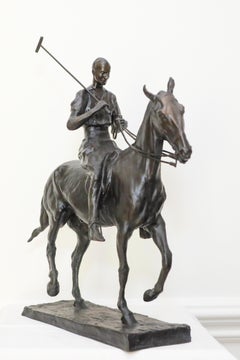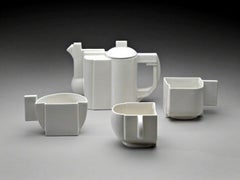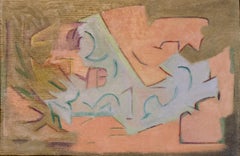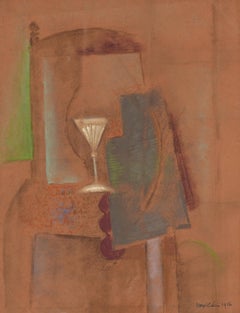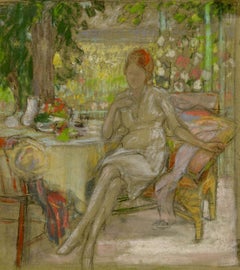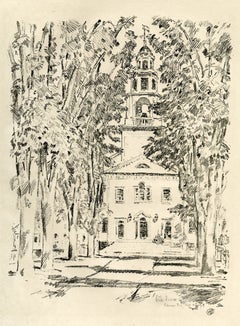1910s Art
to
14
6
6
4
9
4
Overall Height
to
Overall Width
to
450
299
138
132
41
14
11
5
2
2
7
3
2
2
2
1
1
1
1
1
1
1
1
1
1
1
1
17
44
14,667
54,892
5
14
38
91
214
931
2,144
3,968
2,482
1,628
3
2
1
1
1
1
3
3
3
3
2
Style: Abstract
Period: 1910s
Sculpture of a Polo Player Harrison Tweed by Charles Rumsey
Located in Brookville, NY
Polo Pony and Rider Harrison Tweed . Charles Rumsey was an 8 goal polo player with Meadowbrook Polo Club on Long Island NY. He was an avid sportsman, equestrian and artist. His ab...
Category
Abstract Impressionist 1910s Art
Materials
Bronze
Suprematist Tea Service (Limited Edition with signed COA)
Located in New York, NY
Kasimir Severinovich Malevich
Suprematist Tea Service (Limited Edition with signed COA), 1918-1988
Porcelain (Four pieces) with hand signed COA
Certificate of Authenticity, hand numb...
Category
Abstract Geometric 1910s Art
Materials
Porcelain
untitled (Dancing Figure)
By Walt Kuhn
Located in Fairlawn, OH
Dancing Figure
Wood carving with pigment, c. 1913
Unsigned
Provenance: Kuhn Heirs, Maine
Kennedy Galleries, New York, until 1983
...
Category
Abstract 1910s Art
Materials
Wood
"Upper Street" Manierre Dawson, Cubism, Abstract Pastels, Cityscape
By Manierre Dawson
Located in New York, NY
Manierre Dawson
Upper Street, 1912
Oil on board
10 x 15 inches
Provenance:
The artist
Estate of the artist
Private Collection (gift of Lillian Dawson, widow of the artist)
Hollis Ta...
Category
Abstract 1910s Art
Materials
Oil, Board
The Cocktail
By Max Weber
Located in Greenwich, CT
Max Weber was a Russian-born Jewish-American painter best known for introducing Cubism to the United States. Weber’s abstracted depictions of interiors, landscapes, and portraits, we...
Category
Abstract 1910s Art
Materials
Paper, Pastel
Woman on a Patio
Located in Fairlawn, OH
Woman on a Patio
Pastel on paper, c. 1915
Unsigned
Provenance: Gift of the artist to his wife, Mary Hess Buehr
By decent to the artist's niece, daughter of Will Hess
David Saltzman
Robert Henry Adams Fine Art
Thomas French Fine Art
Ronald C. Sloter, Columbus, Ohio
Columbus College of Art and Design (de-accessed)
Exhibited at Robert Henry Adams Fine Art, 1994, the first exhibition at the North Franklin Street Gallery.
One of the early Chicago artists to adopt Impressionism, Karl Buehr became a figure and landscape painter. As a figure painter, his specialty became "gorgeously colored images of young women on porches overlooking brilliant summertime gardens." (Kennedy 98) His later work often showed a female figure with serious expression engaging the viewer with a direct stare. In his landscapes, he was noted for his strong coloration. In a December 1896 student exhibition at the Art Institute, a reviewer for the "Chicago Times Herald" described Buehr's landscapes as "blithe and joyous" with "country roads brilliant in sunlight . . . fields rich in summer verdure, under soft skies painted in a high, musical key." (Gerdts 68)
Buehr was born as one of seven sons to a prosperous German family who immigrated to America and settled in Chicago in 1869. He was first exposed to his signature style of Impressionism in 1888 when he enrolled in night classes at the Art Institute while working in the shipping department of a lithographic firm near the Institute. He remained a student there until 1897 and was recognized in a "Chicago Times Herald" editorial of June 13, 1897 as one of the Institute's most outstanding pupils.
The next year, his art career was temporarily put on hold when he briefly enlisted with the U.S. Army in the Spanish American War. In 1899, he resumed his art studies, this time with Frank Duveneck. He exhibited a painting at the Paris Salon of 1900. In 1905, thanks to a wealthy Chicago patron, Buehr and his family moved to France. They spent the following year in Taormina, Sicily, and spent time in Venice as well. In Paris, Buehr studied at the Academy Julian with Raphael Collin for two years. Then he went to England, enrolling in the London Art School but had returned to Paris by 1908. During this time, he began painting at Giverny, the home of Impressionist leader Claude Monet (1840-1926, and by 1912, Buehr was listing that village as his home address. One of his good friends and associates at Giverny was Frederick Frieseke.
One of Buehr's paintings from that time, "News from Home", was exhibited in 1913 at the French Salon in Paris and at the annual exhibit of the Chicago Art Institute. It shows a woman in floral dress sitting on a porch with a background with potted flowers and lush greenery background. Of his painting done at Giverny, Buehr wrote in 1912 to William Macbeth of Macbeth Galleries in New York: "My figures painted in and around Giverny are costumed and in appropriate out door settings." (Gerdts 68)
In 1914, he returned to the United States and took a teaching position in Chicago at the Art Institute, which he held for the remainder of his life. He was married to Mary Hess, a painter of miniatures and decorative works.
In 1928-29, he was a guest artist at Stanford University.
Courtesy, AskArt
“Karl Albert Buehr (1866–1952) was a painter born in Germany.
Buehr was born in Feuerbach - near Stuttgart. He was the son of Frederick Buehr and Henrietta Doh (Dohna?). He moved to Chicago with his parents and siblings in the 1880s. In Chicago, young Karl worked at various jobs until he was employed by a lithograph company near the Art Institute of Chicago. Introduced to art at work, Karl paid regular visits to the Art Institute, where he found part-time employment, enabling him to enroll in night classes. Later, working at the Institute as a night watchman, he had a unique opportunity to study the masters and actually posted sketchings that blended in favorably with student's work. Having studied under John H. Vanderpoel, Buehr graduated with honors, while his work aroused such admiration that he was offered a teaching post there, which he maintained for many years thereafter. He graduated from the Art Inst. of Chicago and served in the IL Cav in the Spanish–American War. Mary Hess became Karl's wife—she was a student of his and an accomplished artist in her own right. In 1922, he was elected into the National Academy of Design as an Associate member.
Art Studies in Europe
In 1904, Buehr received a bronze medal at the St. Louis Universal Exposition, then, in 1905, Buehr and his family moved to France, thanks to a wealthy Chicago patron, and they spent the following year in Taormina, Sicily, where the artist painted local subjects, executing both genre subjects and landscapes as well as time in Venice. Buehr spent at least some time in Paris, where he worked with Raphaël Collin at the Académie Julian.
Giverny and American Impressionism
Prior to this time, Buehr had developed a quasi-impressionistic style, but after 1909, when he began spending summers near Monet in Giverny, his work became decidedly characteristic of that plein-air style but he began focusing on female subjects posed out-of-doors. He remained for some time in Giverny, and here he became well-acquainted with other well known expatriate America impressionists such as Richard Miller, Theodore Earl Butler, Frederick Frieseke, and Lawton Parker. It seems likely that Buehr met Monet, since his own daughter Kathleen and Monet’s granddaughter, Lili Butler, were playmates, according to George Buehr, the painter’s son. His other daughter Lydia died before adulthood due to diabetes. He returned to Chicago at the onset of World War I and taught at The Art Inst for many years. One of his noted pupils at the Art Institute was Archibald Motley...
Category
Abstract Impressionist 1910s Art
Materials
Pastel
"Days of Pleasure"
Located in Lambertville, NJ
Jim’s of Lambertville is proud to offer this artwork.
Signed on Verso.
Complemented by a hand carved and gilt frame.
Nancy Maybin Ferguson (1...
Category
Abstract Impressionist 1910s Art
Materials
Board, Oil
"Saturday Shoppers, Provincetown"
Located in Lambertville, NJ
Signed lower left. Complemented by a hand carved and gilt frame.
Nancy Maybin Ferguson (1872 - 1967)
A native Philadelphia, Nancy Ferguson wa...
Category
Abstract Impressionist 1910s Art
Materials
Oil, Canvas
Etching 1916 Number II
Located in New York, NY
Wassily Kandinsky (1866-1944), Etching 1916 Number II, drypoint, signed in pencil lower right, titled, numbered (No. 9) and dated lower left [also with initials and date in the plate lower right]. Reference: Roethel 154, only state, edition of 10. In excellent condition (the barest handling fold at sheet edge), printed on a heavy ivory wove paper, the full sheet with full margins, 4 7/8 x 3 1/4, the sheet 17 1/2 x 13 inches, archival mount with window mat.
A fine fresh impression of this great rarity, printed in a dark brown ink.
Kandinsky created this drypoint (erroneously named Etching 1916) in early 1916 while staying with Gabriel Munter in Stockholm during the winter of 1915-16. This is from the second series of drypoints he made; the first was in the year 1913-14.
Provenance: Kornfeld Auction, Bern, June 2007.
The tiny size of this edition (10) makes this print a great rarity within the Kandinsky’s printed...
Category
Abstract 1910s Art
Materials
Drypoint
untitled Woman by the Windows
Located in Fairlawn, OH
Untitled (Woman by the Windows)
Unsigned.
Pastel on board, c. 1915
Created while the artist was in Giverny, France
Provenance:
Gift of the artist to his wife, Mary Hess Buehr
by Descent to the artist's niece, daughter of Will Hess.
David Salzman
Robert Henry Adams Fine Art, Chicago
Ronald C. Sloter, Columbus
One of the early Chicago artists to adopt Impressionism, Karl Buehr became a figure and landscape painter. As a figure painter, his specialty became "gorgeously colored images of young women on porches overlooking brilliant summertime gardens." (Kennedy 98) His later work often showed a female figure with serious expression engaging the viewer with a direct stare. In his landscapes, he was noted for his strong coloration. In a December 1896 student exhibition at the Art Institute, a reviewer for the "Chicago Times Herald" described Buehr's landscapes as "blithe and joyous" with "country roads brilliant in sunlight . . . fields rich in summer verdure, under soft skies painted in a high, musical key." (Gerdts 68)
Buehr was born as one of seven sons to a prosperous German family who immigrated to America and settled in Chicago in 1869. He was first exposed to his signature style of Impressionism in 1888 when he enrolled in night classes at the Art Institute while working in the shipping department of a lithographic firm near the Institute. He remained a student there until 1897 and was recognized in a "Chicago Times Herald" editorial of June 13, 1897 as one of the Institute's most outstanding pupils.
The next year, his art career was temporarily put on hold when he briefly enlisted with the U.S. Army in the Spanish American War. In 1899, he resumed his art studies, this time with Frank Duveneck. He exhibited a painting at the Paris Salon of 1900. In 1905, thanks to a wealthy Chicago patron, Buehr and his family moved to France. They spent the following year in Taormina, Sicily, and spent time in Venice as well. In Paris, Buehr studied at the Academy Julian with Raphael Collin for two years. Then he went to England, enrolling in the London Art School but had returned to Paris by 1908. During this time, he began painting at Giverny, the home of Impressionist leader Claude Monet (1840-1926, and by 1912, Buehr was listing that village as his home address. One of his good friends and associates at Giverny was Frederick Frieseke.
One of Buehr's paintings from that time, "News from Home", was exhibited in 1913 at the French Salon in Paris and at the annual exhibit of the Chicago Art Institute. It shows a woman in floral dress sitting on a porch with a background with potted flowers and lush greenery background. Of his painting done at Giverny, Buehr wrote in 1912 to William Macbeth of Macbeth Galleries in New York: "My figures painted in and around Giverny are costumed and in appropriate out door settings." (Gerdts 68)
In 1914, he returned to the United States and took a teaching position in Chicago at the Art Institute, which he held for the remainder of his life. He was married to Mary Hess, a painter of miniatures and decorative works.
In 1928-29, he was a guest artist at Stanford University.
Courtesy: AskArt
“Karl Albert Buehr (1866–1952) was a painter born in Germany.
Buehr was born in Feuerbach - near Stuttgart. He was the son of Frederick Buehr and Henrietta Doh (Dohna?). He moved to Chicago with his parents and siblings in the 1880s. In Chicago, young Karl worked at various jobs until he was employed by a lithograph company near the Art Institute of Chicago. Introduced to art at work, Karl paid regular visits to the Art Institute, where he found part-time employment, enabling him to enroll in night classes. Later, working at the Institute as a night watchman, he had a unique opportunity to study the masters and actually posted sketchings that blended in favorably with student's work. Having studied under John H. Vanderpoel, Buehr graduated with honors, while his work aroused such admiration that he was offered a teaching post there, which he maintained for many years thereafter. He graduated from the Art Inst. of Chicago and served in the IL Cav in the Spanish–American War. Mary Hess became Karl's wife—she was a student of his and an accomplished artist in her own right. In 1922, he was elected into the National Academy of Design as an Associate member.
Art Studies in Europe
In 1904, Buehr received a bronze medal at the St. Louis Universal Exposition, then, in 1905, Buehr and his family moved to France, thanks to a wealthy Chicago patron, and they spent the following year in Taormina, Sicily, where the artist painted local subjects, executing both genre subjects and landscapes as well as time in Venice. Buehr spent at least some time in Paris, where he worked with Raphaël Collin at the Académie Julian.
Giverny and American Impressionism
Prior to this time, Buehr had developed a quasi-impressionistic style, but after 1909, when he began spending summers near Monet in Giverny, his work became decidedly characteristic of that plein-air style but he began focusing on female subjects posed out-of-doors. He remained for some time in Giverny, and here he became well-acquainted with other well known expatriate America impressionists such as Richard Miller, Theodore Earl Butler, Frederick Frieseke, and Lawton Parker. It seems likely that Buehr met Monet, since his own daughter Kathleen and Monet’s granddaughter, Lili Butler, were playmates, according to George Buehr, the painter’s son. His other daughter Lydia died before adulthood due to diabetes. He returned to Chicago at the onset of World War I and taught at The Art Inst for many years. One of his noted pupils at the Art Institute was Archibald Motley...
Category
Abstract Impressionist 1910s Art
Materials
Pastel
Self Portrait
Located in New York, NY
Walter Helbig
Self Portrait, 1919
woodcut
17 3/8 x 12 1/2 in. (44.1 x 31.8 cm)
Category
Abstract Expressionist 1910s Art
Materials
Woodcut
Russian Ballet.
Located in New York, NY
BOMBERG, David. Russian Ballet. With 6 original color lithographs by David Bomberg. London; Hendersons. [The Bomb Shop] 1919. 8 3/8 x 10 1⁄2 Inches, 8 ...
Category
Abstract 1910s Art
Materials
Lithograph
Picasso, Homme dans un interiéur jouant de la guitare
Located in Miami, FL
Drawn in 1912 by Picasso, this fine piece of work is a recognizable mark of his unique style. "Homme dans un interiéur jouant de la guitare", 1912 is on cream laid paper, with abstra...
Category
Abstract 1910s Art
Materials
Paper, Pencil
Scene for a Fairy Tale
Located in New York, NY
WADSWORTH, Edward. Scene for a Fairy Tale, ca 1918. Woodcut printed in black on cream wove paper, Signed in pencil (which is rare for a Wadsworth rarely signed his woodcuts). Ref: Colnaghi 126. [Exhibited as Untitled Abstract]
Edward Wadsworth was an English artist, most famous for his close association with Vorticism. He painted, often in tempera, coastal views, abstracts, portraits and still-life. He was also an engraver on wood and copper. In the First World War he was involved in transferring dazzle camouflage...
Category
Abstract 1910s Art
Materials
Woodcut
Related Items
"Up Side Down" Bronze Sculpture Edition 3/8 by Huang Yulong
By Huang Yulong
Located in Culver City, CA
"Up Side Down" Bronze Sculpture Edition 3/8 by Huang Yulong
Up Side Down
2018
Bronze sculpture
24" × 4" × 4" in
60 × 10 × 10 cm
Edition of 3/8
ABOUT TH...
Category
Contemporary 1910s Art
Materials
Bronze
"YoBro!! 2" Bronze Sculpture 90" x 20" x 16" inch Edition 3/3 by Huang Yulong
By Huang Yulong
Located in Culver City, CA
"YoBro!! 2" Bronze Sculpture 90" x 20" x 16" inch Edition 3/3 by Huang Yulong
YoBro!!2
2015
Bronze sculpture
92 1/2 × 19 7/10 × 15 7/10 in
235 × 50 × 40 cm
Edition of 3 + 2AP
Wei...
Category
Contemporary 1910s Art
Materials
Bronze
"Peaches" Bronze Sculpture Edition 1/8 by Huang Yulong
By Huang Yulong
Located in Culver City, CA
"Peaches" Bronze Sculpture Edition 1/8 by Huang Yulong
Figure size: 37" x 16" x 8" inch
Stand size: 35" x 22" x 22" inch
ABOUT THE ARTIST
Huang Yulong was born in 1983 in Anhui Pr...
Category
Contemporary 1910s Art
Materials
Bronze
Landscape - XXI century, Contemporary Oil & Acrylic Painting, Abstraction
By Monika Rossa
Located in Warsaw, PL
MONIKA ROSSA
studied painting at the University of Arizona, in the Ecole des Beaux Arts in Paris and at the Escuela de Diseno in Barcelona. She practices drawing and easel painting....
Category
Abstract 1910s Art
Materials
Oil, Acrylic, Board
Abstract Figure
By Raul Diaz
Located in Wilton Manors, FL
Raul Diaz (Argentina, b.1950). Abstract Figure, ca. 1970s. Canved Walnut. Measures 17 inches tall including wood base. Carved signature in lower region. Excellent condition.
An ear...
Category
Abstract Expressionist 1910s Art
Materials
Walnut
Untitled Floral Still Life
Located in Wilton Manors, FL
Beautiful floral still life by American artist Jane Piper (1916-1991) . Pastel, oil crayon and pencil on tracing paper. Image measuring 13 x 15.5 inches in original frame measuring 2...
Category
Abstract 1910s Art
Materials
Parchment Paper, Crayon, Pastel, Pencil
IKONA - Organic Circle Metal Wall Art Sculpture
By ENNAIA
Located in Weslaco, TX
This piece plays with our perception, as well as challenges our definition of the chaotic and the perfect. When viewed from the front, the perceived silhouette is that of a perfect c...
Category
Abstract Geometric 1910s Art
Materials
Steel, Stainless Steel
Wanderer's Pizza
By Drew Leshko
Located in Philadelphia, PA
"Wanderer's Pizza" is an original paper, enamel, pastel, inkjet prints, chain, wire, and tubing artwork by Drew Leshko measuring approx. 11.5"h x 7.25"w x 0.75"d.
Drew Leshko is a P...
Category
Contemporary 1910s Art
Materials
Enamel, Wire
GOLDEN CACTUS Plant Original Interior Sculpture
Located in Valencia, ES
Made in Ukraine, 2020.
Meet this big interior golden cactus sculpture.
Location and Delivery from: Ukraine
Authors: Created by Rostyslav Kozhman and Iryna Antoniuk (Irena Tone)
Mat...
Category
Abstract Geometric 1910s Art
Materials
Steel
No Reserve
H 43.31 in W 15.75 in D 15.75 in
Mercedes Matter, New York School Abstract Figures
Located in New York, NY
Mercedes Carles Matter (1913 - 2001)
Untitled, circa 1937
Pastel on paper
16 x 13 1/2 inches
Estate stamped on the reverse
Provenance:
Estate of the artist
Spanierman Gallery, New York
Private Collection, Pennsylvania circa 2013
Private Collection, New York, 2021
Mercedes Matter was born in New York in 1913. Her father, the American modernist Arthur B. Carles, had studied with Matisse. Her mother, Mercedes de Cordoba, was a model for Edward Steichen. Ms. Matter grew up in Philadelphia, New York and Europe.
She began painting under her father's supervision at age 6, and studied art at Bennett College in Millbrook, N.Y., and then in New York City with Maurice Sterne, Alexander Archipenko and Hans Hofmann.
In the late 1930's, she was an original member of the American Abstract Artists organization and worked for the federal Works Progress Administration, assisting Fernand Léger on his mural for the French Line passenger ship company. Léger introduced her to Herbert Matter, the Swiss graphic designer and photographer, whom she married in 1939.
The Matters were active in the emerging New York art scene and also traveled frequently to Europe. Their closest friends included Jackson Pollock, Lee Krasner, Franz Kline, Philip Guston, Alexander Calder and Willem de Kooning. They were also close to Alberto Giacometti, who was an important artistic role model for Mrs. Matter and a frequent photographic subject for her husband.
Beginning in 1953, Mrs. Matter taught at the Philadelphia College of Art (now University of the Arts), Pratt Institute and New York University. Based on her teaching experiences she wrote an article for Art News in 1963 titled ''What's Wrong with U.S. Art Schools?'' In it, she lamented the phasing out of the extended studio classes required to initiate ''that painfully slow education of the senses,'' which she considered an artist's life work.
The article prompted a group of Pratt students to ask her to form a school based on her ideas, which led, in 1964, to the founding of the New York Studio School. Originally in a loft on Broadway, the school gained almost immediate support from the Kaplan Fund, the Rockefeller Brothers Fund and the Ford Foundation. It granted no degrees, had only studio classes and emphasized drawing from life. Its teachers, chosen by the students, included the artists Guston, Bradley Walker Tomlin, Charles Cajori, Louis Finkelstein...
Category
Abstract Expressionist 1910s Art
Materials
Oil Pastel, Paper, Pastel
Abstract Geometric Terracotta Jugs, Mid Century Modern Abstracted Still Life
Located in Soquel, CA
Bold mid century modern abstracted pastel on paper still life of several terra cotta jugs and vessels distilled down to their most basic shapes and ar...
Category
Abstract Geometric 1910s Art
Materials
Paper, Pastel
H 24.25 in W 29.75 in D 1.25 in
Tiny Stainless Steel Bear 'Ricky' Sculpture Minimalistic Animal
Located in Valencia, ES
IMPORTANT: Every artwork is entirely hand-made and unique, collected by the sculptor's hands and eyes. So there are not totally similar items even if they look similar and there are ...
Category
Abstract Geometric 1910s Art
Materials
Steel, Stainless Steel
H 5.52 in W 3.94 in D 4.73 in
Previously Available Items
Der Blauer Reiter - Study for Composition Nr. 4 abstract Kandinsky lithograph
Located in Hamburg, DE
"Der Blaue Reiter - Entwurf zur Komposition Nr. 4" from 1914 is a color lithograph of Wassilij Kandinsky which contains hand-coloring and pochoir. Monographed bottom left. Watermark...
Category
Abstract Expressionist 1910s Art
Materials
Handmade Paper, Lithograph
Wassily KandinskyDer Blauer Reiter - Study for Composition Nr. 4 abstract Kandinsky lithograph, 1914
H 13 in W 14.97 in D 0.79 in
Colonial Church, Gloucester
Located in Fairlawn, OH
Signed, titled, and dated in the stone lower right.
Artist's cipher lower right (see photo)
Edition: 101
An impression of this lithograph is in the National Gallery of Art, Washington and the Metropolitan Museum of Art, New York
Hassam also created a painting of this historic Gloucester landmark in 1918 which is in the collection of the Metropolitan Museum of Art.
The Universalist Independent Christian Church in Gloucester, Massachusetts was dedicated in 1806 and housed a congregation associated with the granting of religious freedom to all denominations. It was also celebrated for its bell, cast at Paul Revere's foundry.
Reference: Fuller Griffith, "The Lithographs of Childe Hassam: A Catalogue," Bulletin U.S. National Museum, Smithsonian Institution 232 (1962):, No. 41
Condition: Excellent
Image size: 13 3/4 x 10 1/2 inches
Sheet size: 17 1/2 x 12 3/8 inches
Provenance: Kennedy Galleries
Mrs. George A. Martin
Baldwin Wallace College, deaccessioned 2010
"Childe Hassam (1859–1935), a pioneer of American Impressionism and perhaps its most devoted, prolific, and successful practitioner, was born in Dorchester, Massachusetts (now a suburb of Boston), into a family descended from settlers of the Massachusetts Bay Colony. Equally adept at capturing the excitement of modern cities and the charms of country retreats, Hassam (properly pronounced HASS-am) became the foremost chronicler of New York City at the turn of the century. In our day, he is perhaps best known for his depictions of flag-draped Fifth Avenue during World War I (67.187.127). His finest works manifest his brilliant handling of color and light and reflect his credo (stated in 1892) that “the man who will go down to posterity is the man who paints his own time and the scenes of every-day life around him.”
After establishing his reputation in Boston between 1882 and 1886, Hassam studied from 1886 to 1889 in Paris. There he was unusual among his American contemporaries in his attraction to French Impressionism, which was just beginning to find favor with American collectors. Hassam returned to the United States late in 1889 and took up lifelong residence in New York. His signature images include views of Boston, Paris, and New York, three urban centers whose places and pleasures he captured with affection and originality. Examples include Winter in Union Square (43.116.2) and Spring Morning in the Heart of the City (43.116.1), both of which record lively sections of New York during the first decade of Hassam’s activity there.
While Hassam was unusual among the American Impressionists for his frequent depictions of burgeoning cities, he spent long periods in the countryside. There he found respite from urban pressures and inspiration for numerous important works of art. Hassam’s many portrayals of the old-fashioned gardens, rocky coast, and radiant sunlight of the Isles of Shoals...
Category
Abstract Impressionist 1910s Art
Materials
Lithograph
Der Blauer Reiter - Study for Composition Nr. 4 abstract Kandinsky lithograph
Located in Hamburg, DE
"Der Blaue Reiter - Entwurf zur Komposition Nr. 4" from 1914 is a color lithograph of Wassilij Kandinsky which contains hand-coloring and pochoir. Monographed bottom left. Watermark...
Category
Abstract Expressionist 1910s Art
Materials
Handmade Paper, Lithograph
Wassily KandinskyDer Blauer Reiter - Study for Composition Nr. 4 abstract Kandinsky lithograph, 1914
H 14.57 in W 16.93 in D 1.58 in
Newport or The Cliffs at Newport
By Ruel Crompton Tuttle
Located in Fairlawn, OH
Newport or The Cliffs at Newport
Watercolor on board, 14 x 20 inches
Signed, titled and dated lower left corner (see photo)
This scenic vista is now part of the Cliff Walk at Newport...
Category
Abstract Impressionist 1910s Art
Materials
Watercolor
Original 1916 Mangez moins de viande pour ménager notre cheptel vintage poster
Located in Spokane, WA
Original French vintage Mangez moins de viande pour ménager notre cheptel color lithographed poster signed "Martha Picard, 16 years old,. Municipal School, Boulevard Pereire 221". Th...
Category
Abstract Expressionist 1910s Art
Materials
Lithograph
H 21.5 in W 14.5 in D 0.07 in
Jungster Tag
Located in Fairlawn, OH
Signed in the block with the artist's initials
Judgement day (Jungster Tag)
Originally published in Klange (Sounds), 1913, edition 345
This impression is from “Homage to Wassily Kandinsky,” special Issue of XXe Siecle.
Edited by G. San Lazzaro and published by Leon Amiel for A. Maeght, Paris, 1975
Note: Vasily Kandinsky's self-described "musical album," Klänge (Sounds), consists of thirty-eight prose-poems he wrote between 1909 and 1911 and fifty-six woodcuts he began in 1907.
Klänge is one of three major publications by Kandinsky that appeared shortly before World War I, alongside Über die Geistige in der Kunst (Concerning the Spiritual in Art) and the Blaue Reiter almanac...
Category
Abstract 1910s Art
Materials
Woodcut
Black Spot
Located in San Francisco, CA
Original woodcut printed in black ink on wove paper.
Signed in the block with the artist’s monogram (the letter “K” in a triangle) lower left.
An impression of Roethel’s second an...
Category
Abstract 1910s Art
Materials
Woodcut
Motif from Improvisation No. 25
Located in San Francisco, CA
Original woodcut printed in black ink on wove paper.
Signed with the artist’s monogram, the letter “K” in a triangle, in the block lower right.
A superb impression of the defini...
Category
Abstract 1910s Art
Materials
Woodcut
"Zwei Frauen in Mondlandschaft (Two Women in Moonlight), " by Wassily Kandinsky
Located in Milwaukee, WI
"Zwei Frauen in Mondlandschaft (Two Women in Moonlight) Ref Roethel #100" is an original color woodcut by Wassily Kandinsky. It is from an edition of 300. The artist put his initials...
Category
Abstract Expressionist 1910s Art
Materials
Woodcut
Sardine Boats, Brittany
Located in Fairlawn, OH
Signed, titled, and editioned in pencil by the artist
Edition: 80/100
From the Estate of the Artist
By decent
Sheet: 17 3/8 x 14 5/8";
Image: 11 1/8 x 10 1/2";
Bor...
Category
Abstract Impressionist 1910s Art
Materials
Aquatint
"Orientalisches from Klange Cat, " Original Color Woodcut by Wassily Kandinsky
Located in Milwaukee, WI
From Wassily Kandinsky's Klange series is "Orientalisches" (Cat. Ref. Rothel #106.) It is an abstract original color woodcut in three colors and is the second edition.
5" x 7 1/2" a...
Category
Abstract 1910s Art
Materials
Woodcut
Banana Toters, New Orleans
Located in Fairlawn, OH
Banana Toters, N.O.
Etching & Color aquatint, 1916-1917
Signed, titled, and annotated "No. 2" in pencil by the artist
Edition: Intended edition of 100 never realized -- Very rare
Bor...
Category
Abstract Impressionist 1910s Art
Materials
Etching, Aquatint
